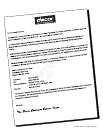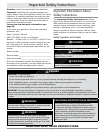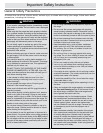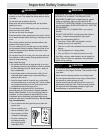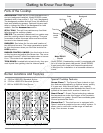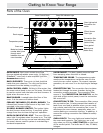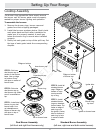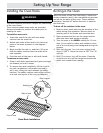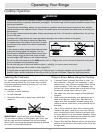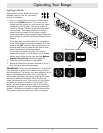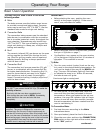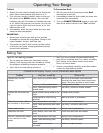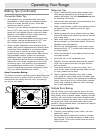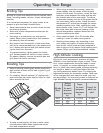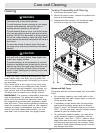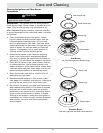
8
Operating Your Range
Things to Know Before Using the Cooktop
A normal flame is steady and blue in color. For-•
eign material in the gas line, especially in new
construction, may cause an orange flame during
initial operation. This color will disappear with
further use. Small yellow tips on the ends of the
flames are normal when using LP gas.
See page 4 for the heat ranges of the different •
burners.
Food cooks just as quickly at a gentle boil as it •
does at a vigorous, rolling boil. Maintaining a
higher boil than necessary wastes energy and
cooks moisture, food flavor, and nutrients out of
the food.
Use a low or medium flame when cooking with •
utensils like glass, ceramic or cast iron that are
poor conductors of heat. Reduce the flame until
it covers about 1/3 of the utensil diameter. Doing
so will ensure even heating and reduce the likeli-
hood of burning or scorching the food.
Dacor’s SimmerSear feature allows you precision •
control of the flame on the dual burner, from low
to high heat.
Selecting the Cookware
For overall safety and best performance, select the
correct cooking utensil for the food being cooked.
Improperly selected cooking utensils will not cook
evenly or efficiently.
Use cookware that:
Has flat, smooth bottoms.•
Is well balanced.•
Has tight fitting lids to keep heat, odors and •
steam in.
IMPORTANT: Avoid spills as much as possible.
The porcelain surfaces of the grates, spill trays and
burner caps are acid-resistant but not acid-proof.
Some foods can cause permanent damage if allowed
to remain on porcelain surfaces.
Cooktop Operation
To avoid the chance of fire, explosion or carbon monoxide poisoning, do not attempt to use your range without the •
burners completely and properly assembled (see page 6). The burner rings must be properly seated for proper burner
lighting and operation.
To avoid burns and scalding, always turn pan handles to a position where they cannot be easily hit. Also, handles •
should not extend over adjacent burners. Always set utensils gently onto the grates and center them so that they are
well-balanced.
Do not drag cookware across the grates. Sliding may damage the finish. Lift utensils to reposition them. Do not drop •
them on the grate.
Cookware with rough bottoms can cause permanent damage to the coated surfaces on the grates.•
To avoid burns or fire hazard, reduce the flame level •
if it extends beyond the bottom of the utensil. A flame
that extends up the sides of the utensil is potentially
dangerous.
In the interest of safety, always light the burner before •
putting the cooking utensil on the grate. Turn the
burner knob to the OFF position before removing the
utensil. Always check all the burner knobs to make
sure the range is OFF when you are finished cooking.
Do not turn the knob farther than the • HIGH position until lit. Doing so may result in a burst of flame that could cause
burns or damage to the surrounding area.
Do not touch any part of the burner while the igniter is sparking. An electric shock could result.•
Never light the burners with a match or other open flame.•
If the gas does not ignite after four seconds or if the flame goes out and gas escapes, turn the knob to the • OFF
position. Open a window and allow at least five minutes for the gas to dissipate. Repeat the lighting procedure.
WARNING



